Baked miso-ginger and spicy, citrusy yuzu-marinated salmon with tender asparagus on a sheet tray. Served with brown sushi rice, creamy avocado chunks, and an egg fried in sesame seeds for a nutty crunch. Then, it is drizzled with hot and tangy sriracha sauce and toasted sesame oil, creating an incredible pairing of textures and flavors for this Miso Salmon Rice Bowl.

Table of Contents
Jump to:
- From Thailand to Japan to Korea
- About Miso Paste
- About Sriracha
- Toasted Sesame Oil
- Ingredients with Steps
- Culinary Glossary
- Instructions with Pictures
- Equipment
- Kitchen Must-Haves Reviews
- Substitutions
- Variations
- Storage
- Cooking Tip
- Frequently Asked Questions
- Rice Bowl Recipes
- Seafood Recipes
- Subscribe to My YouTube Channel
- 📖 Recipe
- Have a Comment or Question?
From Thailand to Japan to Korea
Taste the vibrant flavors of the Easy Sheet Pan Spicy Miso Salmon Rice Bowl, a culinary masterpiece made just for you! This delightful dish features succulent salmon fillets marinated in a rich blend of miso, ginger, and spicy, citrusy yuzu, then baked to perfection alongside tender asparagus on a sheet tray.
The salmon is served over a bed of nutty brown sushi rice, complemented by creamy avocado chunks and an egg fried with sesame seeds for an added nutty crunch. To elevate this bowl of goodness, it's generously drizzled with hot and tangy sriracha sauce and aromatic toasted sesame oil, offering an irresistible combination of textures.
About Miso Paste
Miso paste, a traditional Japanese seasoning made from fermented soybeans, rice, or barley, and salt, has been a staple in Japanese cuisine for over a thousand years. Originating from ancient China and introduced to Japan around the 7th century, miso became essential to the Japanese diet, used in soups, marinades, and pickling.
Its deep, umami-rich flavor and health benefits due to probiotics and nutrients made it indispensable. Over time, miso's versatility and unique taste caught the attention of global chefs, leading to its incorporation into modern international cuisines.
Today, miso enhances diverse dishes worldwide, from salad dressings to marinades for meats, like this Easy Sheet Pan Spicy Miso Salmon Rice Bowl. It shows its remarkable ability to blend seamlessly with various ingredients and cooking styles.
Japanese Miso Paste VS Korean Soybean Paste
Though both Japanese miso paste and Korean soybean paste are derived from fermented soybeans, they have distinct flavor and texture differences. Japanese miso, typically made with soybeans and rice or barley, has a smoother texture and varies in flavor from sweet and mild (white miso) to robust and salty (red miso).
On the other hand, Korean soybean paste, or doenjang, has a chunkier texture with a stronger, earthier, and pungent flavor due to its pure soybean composition and longer fermentation process.
Despite these differences, both can be used interchangeably in recipes. Their umami richness and deep, savory notes complement the marinated salmon in this recipe, enhancing the dish's complexity and depth of flavor.
About Sriracha
Sriracha is a spicy chili sauce originating from Thailand. It's a crucial ingredient in this dish, bringing out the zesty, bold flavor this bowl needs. It is made from a blend of chili peppers, vinegar, garlic, sugar, and salt. Named after the coastal city of Si Racha, it has gained worldwide popularity due to its unique combination of heat, sweetness, and tanginess.
Initially used as a condiment for seafood, it has now become a versatile staple in various cuisines globally. Sriracha is commonly used to add a spicy kick to dishes such as soups, noodles, sandwiches, and even cocktails, making it a beloved addition to kitchens and restaurants around the world for those seeking a burst of bold flavor.
Toasted Sesame Oil
Toasted sesame oil, a staple in Korean cuisine, is known for its rich, nutty flavor and aromatic quality. It is often used as a finishing touch in rice bowl dishes like bibimbap and various banchan (side dishes).
Its deep, roasted taste enhances the overall flavor profile, adding depth and complexity to simple ingredients. When drizzled over this Miso Salmon Rice Bowl, toasted sesame oil imparts a warm, savory note that complements the spicy miso-marinated salmon and the nutty crunch of the sesame-fried egg.
This addition elevates the dish's flavor and brings a touch of Korean cuisine inspiration to the recipe, creating a delightful fusion of tastes and textures.

Looking for authentic Thai, Korean, and Japanese recipes? Check out Hot Thai Kitchen, My Korean Kitchen, and Just One Cookbook.
More Delicious Salmon Recipes
- Sesame Chili Salmon Rice Bowl
- Calabrian Pepper Basil Baked Salmon and Broccolini
- Air Fryer Spicy Cilantro Lime Salmon Salad Rice Bowl
- Baked Cajun Honey Mustard Salmon Cauliflower Steaks & Potatoes
Ingredients with Steps
To prepare the Easy Sheet Pan Spicy Miso Salmon Rice Bowl, start by cooking brown sushi rice either in a rice cooker with a 2:1 water-to-rice ratio or on the stovetop with 2 ½ cups of water per cup of rice, simmering for about 45-50 minutes.
Preheat the oven to 400°F. Make the salmon marinade by combining miso paste, mirin, rice vinegar, soy sauce, ginger paste, sesame oil, and yuzu pepper sauce. Line a sheet pan with parchment paper. Prepare the salmon filet by placing it on the pan and covering it with the marinade.
Arrange trimmed asparagus beside the salmon, drizzling with avocado oil and seasoning with kosher salt and ground black pepper. Bake for 15-20 minutes until the salmon reaches 145°F and the asparagus is tender. Meanwhile, fry eggs with sesame seeds in a non-stick pan.
Once everything is cooked, flake the salmon and cut the asparagus into pieces. Assemble the bowls by evenly distributing the rice, asparagus, and salmon, adding diced avocado, placing a fried egg on top, and drizzling with sriracha and sesame oil. Optionally, sprinkle more sesame seeds or salmon furikake for added flavor.
Culinary Glossary
This section provides concise definitions of key ingredients and techniques to enhance understanding and improve cooking skills related to this recipe.
- Sushi Rice - Also known as short-grain rice, it is typically used in some East Asian dishes; it tends to be stickier than medium-grain rice, like Jasmine or long-grain rice like basmati rice.
- Miso Paste - A traditional Japanese seasoning made from fermented soybeans, rice, or barley, and salt. It is known for its umami-rich flavor. I interchangeably use this with Korean soybean paste.
- Mirin - This is a sweet Japanese rice wine with a syrupy consistency. It is used for cooking, adding a mild sweetness and depth of flavor to dishes.
- Rice Vinegar - This mild, slightly sweet vinegar is made from fermented rice and is commonly used for dressings, marinades, and sushi rice. Regular and seasoned vinegars are available. The seasoned version is usually used for sushi rice.
- Ginger Paste - A convenient ingredient of ginger in paste form, it can be found at your local Asian market.
- Toasted / Roasted Sesame Oil - This is a more refined sesame oil used at the end of a dish for flavor, typically not cooked with.
- Yuzu Hot Pepper Sauce - This hot sauce is made from chili peppers and yuzu. Yuzu is a Japanese citrus fruit that some would say tastes similar to lemon and lime.
- Salmon Filet - Try to get fresh, uniform whole filets to cook evenly when baking salmon instead of portioned filets. This will keep it moist.
- Asparagus - Use jumbo asparagus, which will cook simultaneously with the salmon when baked.
- White Sesame Seeds - The sesame seeds will toast very quickly; do not wait for them to turn golden brown before adding the eggs, as they will continue to toast while frying the eggs in the hot pan.
- Sriracha Sauce - This is a Thai red, salty, tangy, and spicy thick chili sauce made with chili peppers, vinegar, garlic, sugar, and salt, used as a condiment to add heat and tang to dishes.
- Salmon Furikake - This rice seasoning mixture is a Japanese blend typically made from dried fish, sesame seeds, seaweed, sugar, and salt. It is sprinkled over rice and other dishes for added flavor and texture.
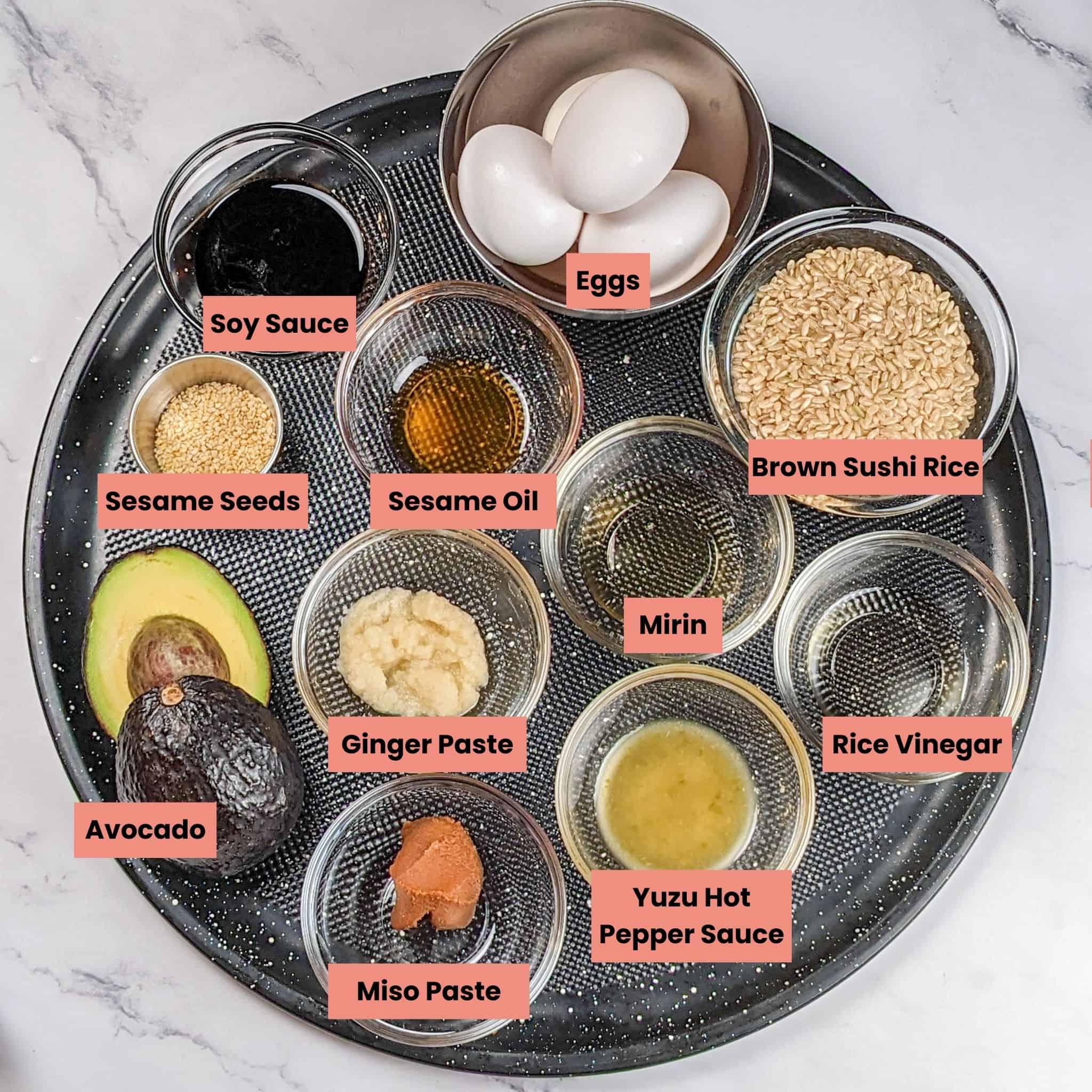
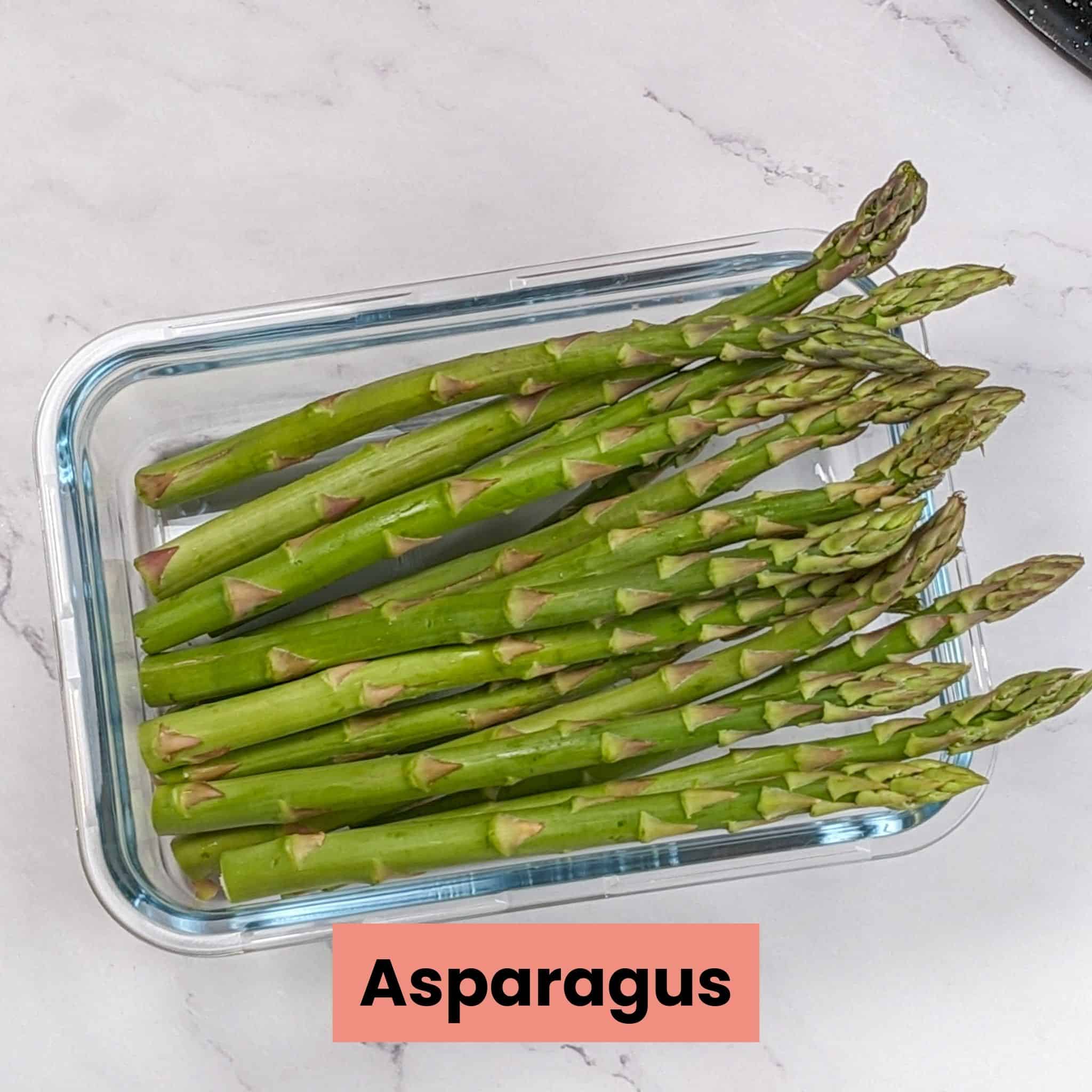
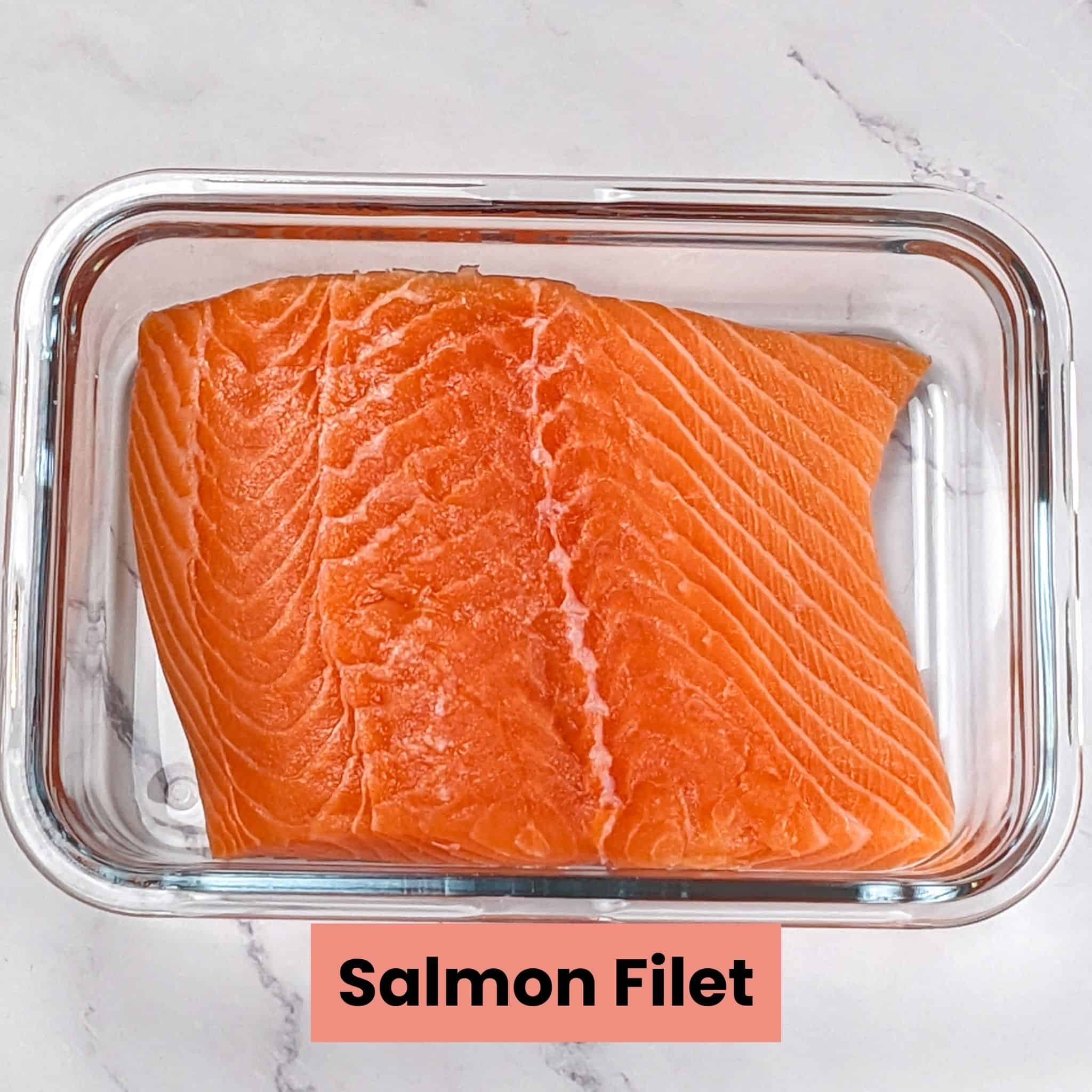
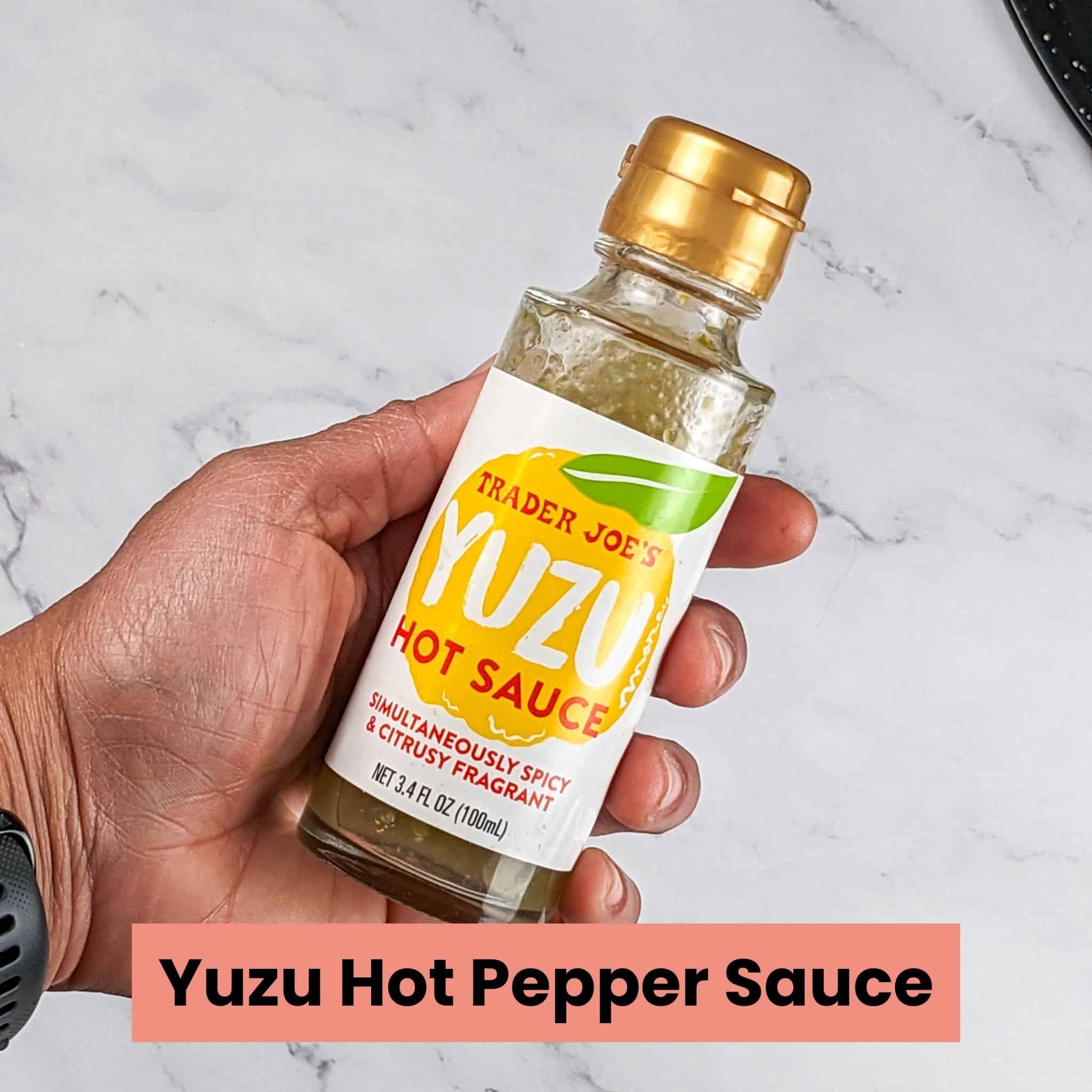
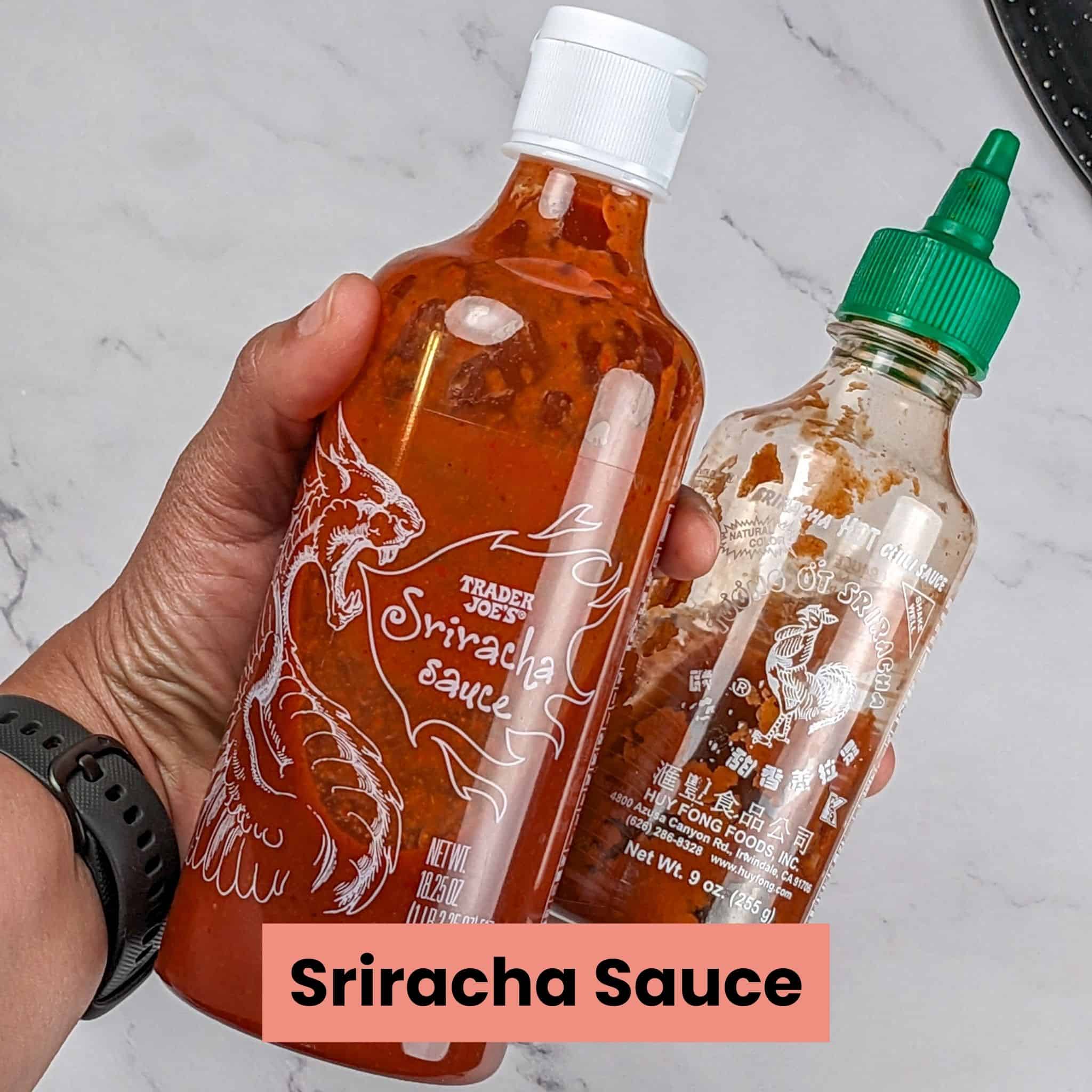
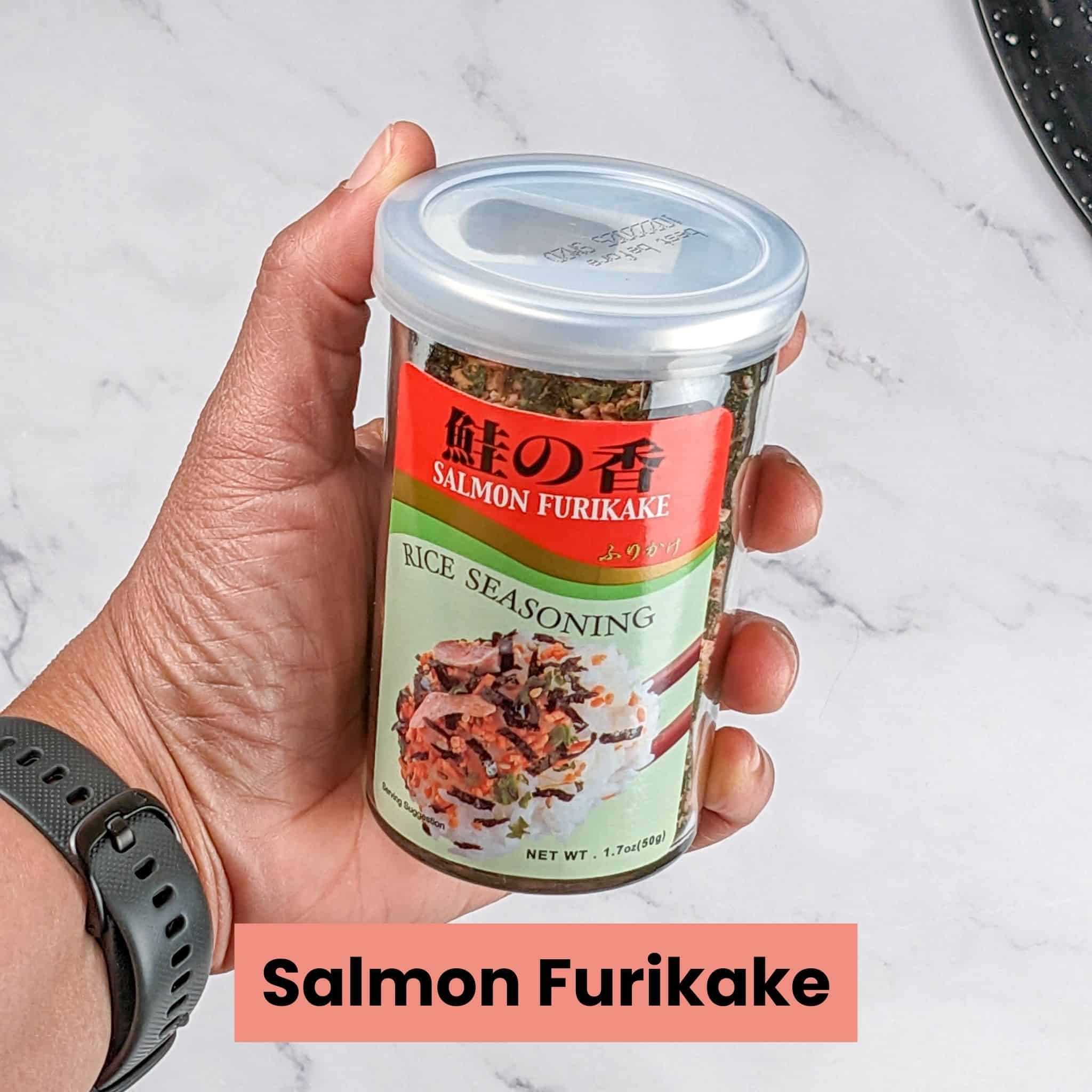
Instructions with Pictures
Follow the instructions and cooking tips below using the step-by-step picture guide.
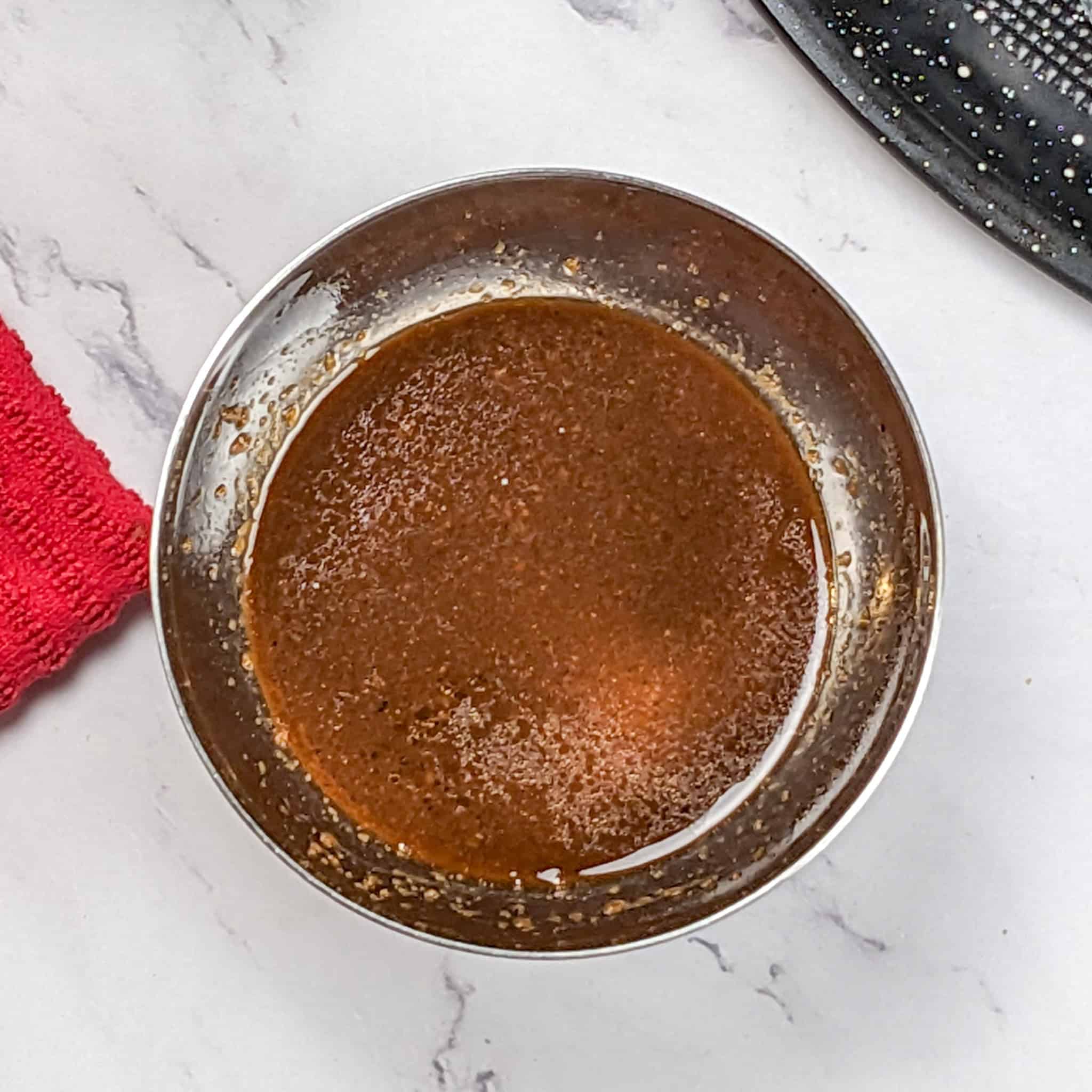
To create a smooth sauce, use a whisk to smash and incorporate the miso paste with the rest of the ingredients.
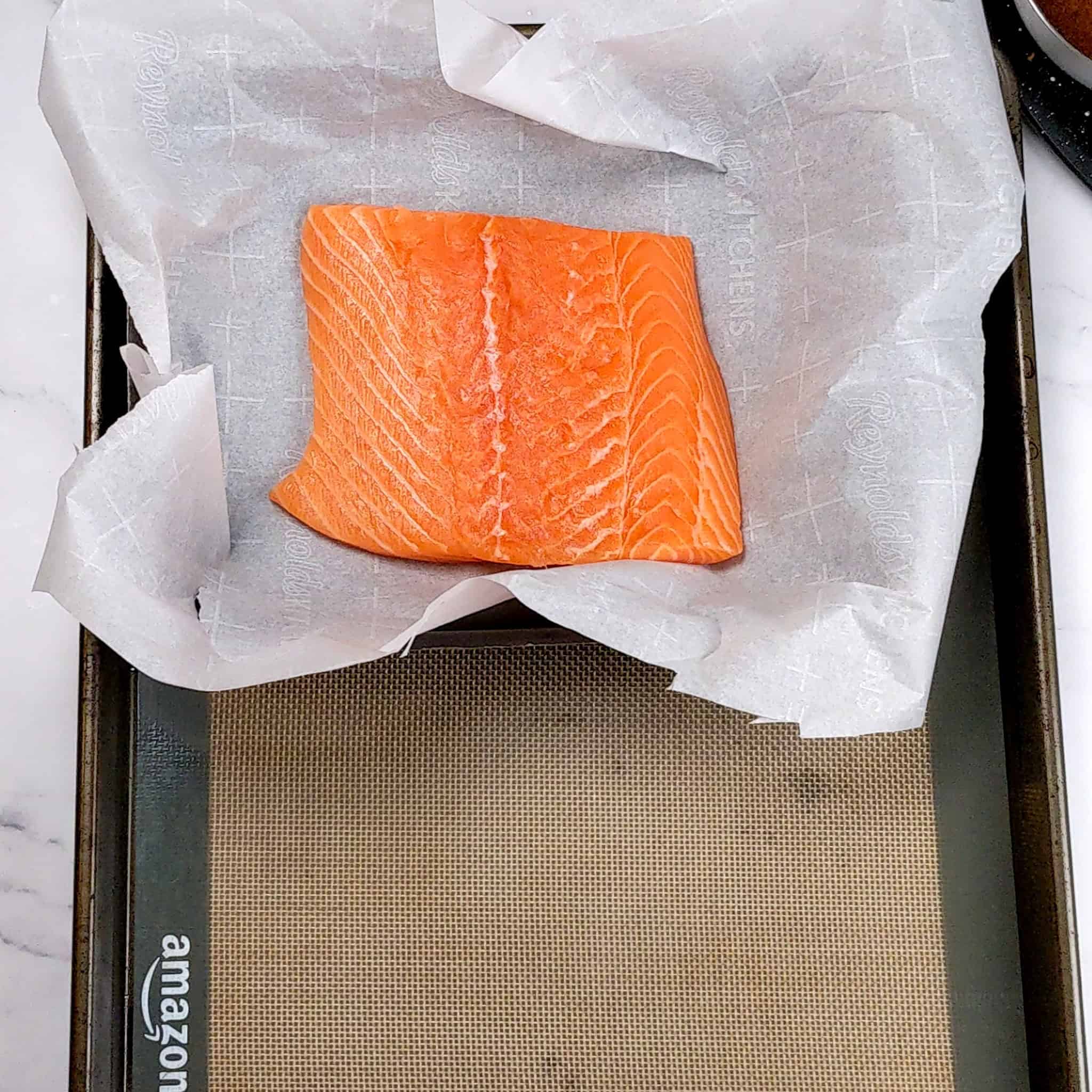
Placing the salmon in a baking dish prevents leaking. And the parchment paper creates an easy cleanup.
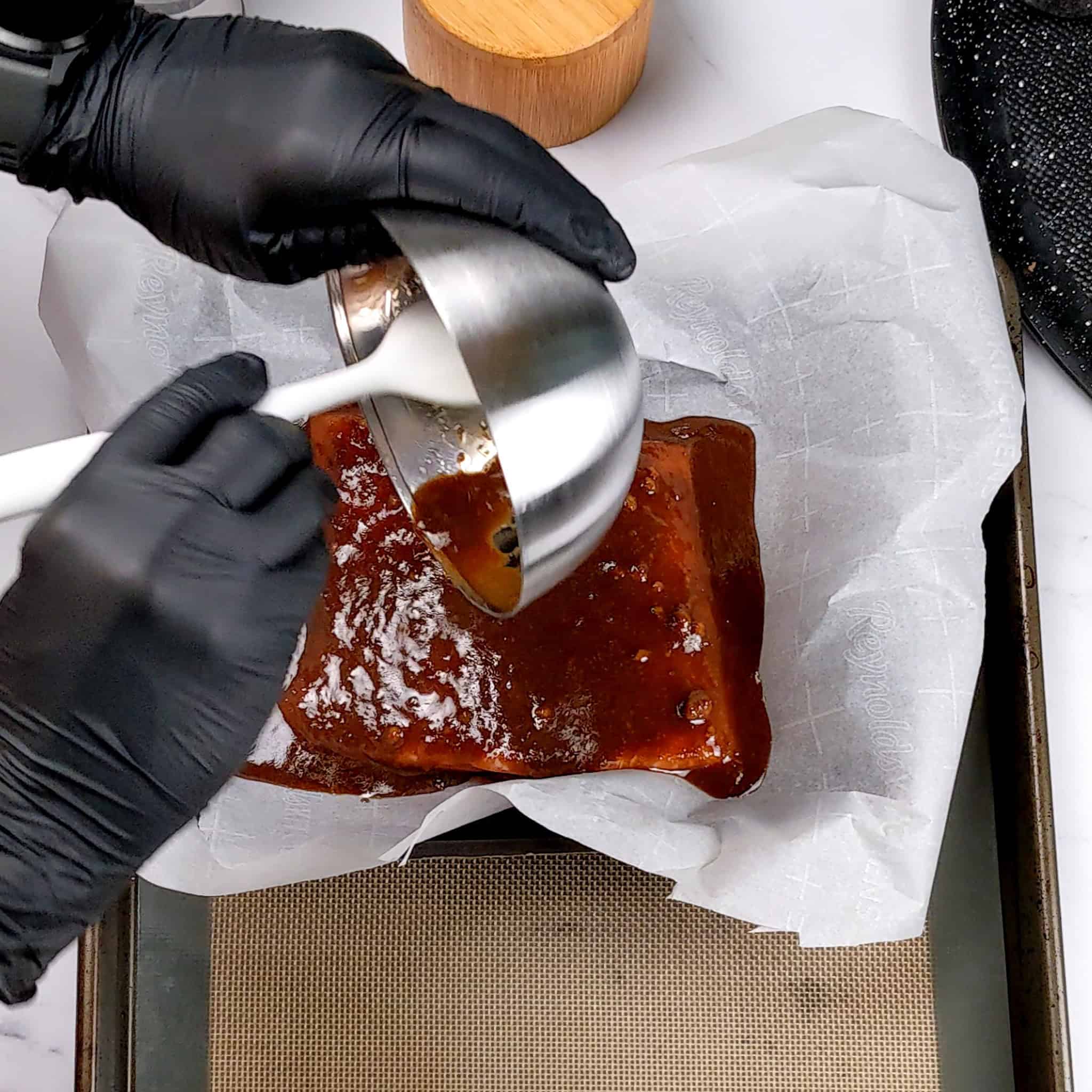
The marinade does not need much time to marinate since it will bake in the sauce and be mixed into it later.
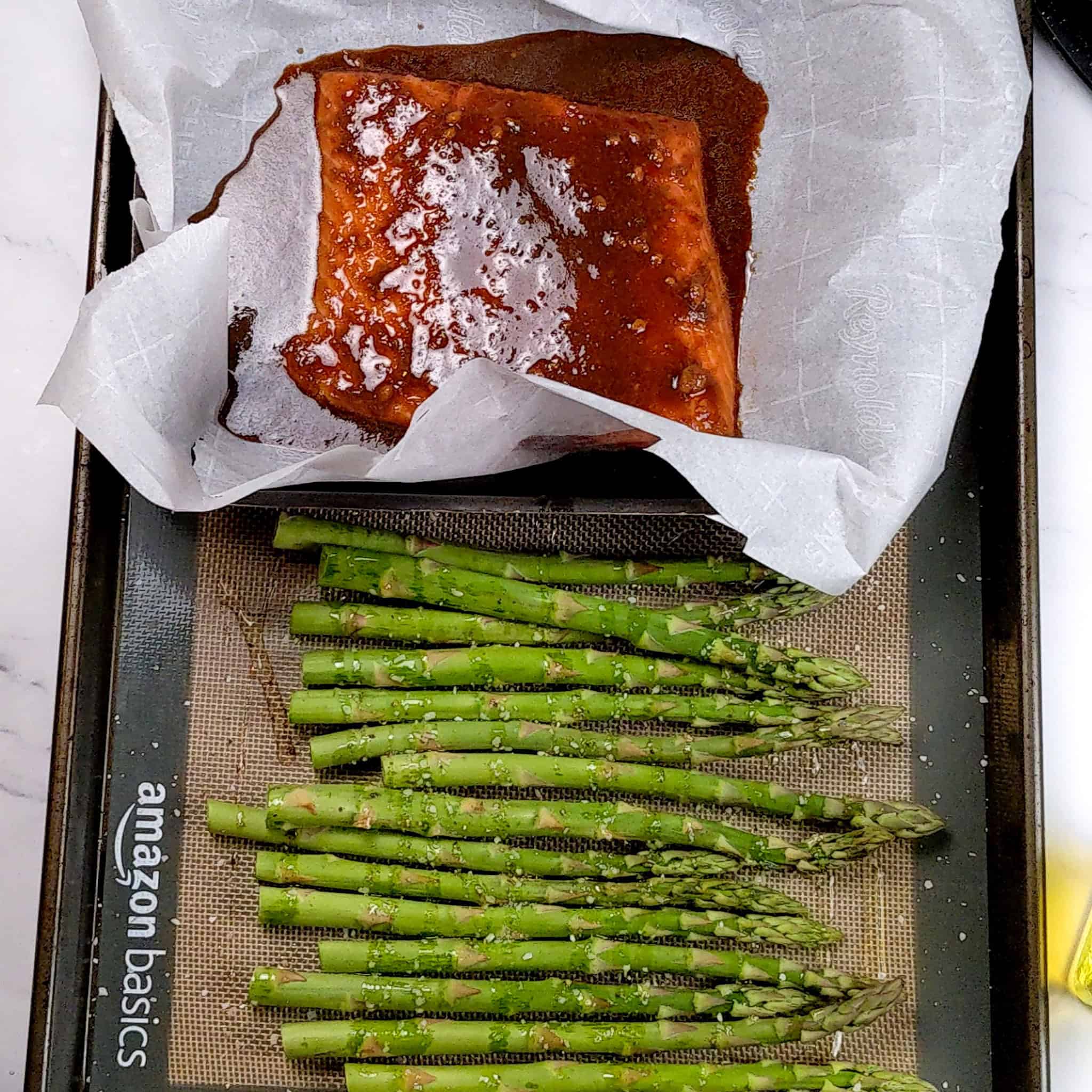
One sheet pan for both items helps insert and remove the food from the oven.
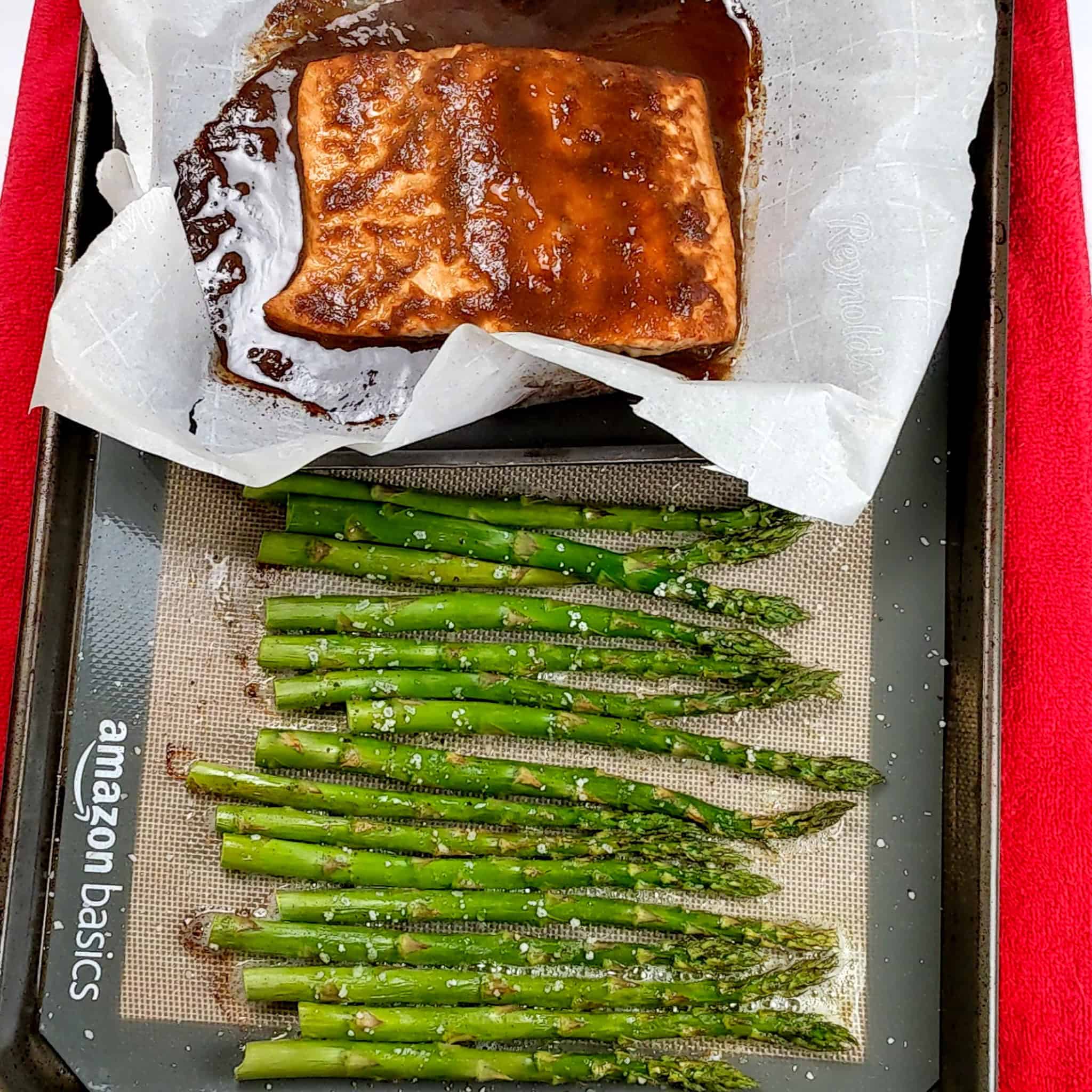
The salmon should be cooked to an internal temperature of 145 degrees Fahrenheit, and the asparagus should be bright green, tender, and firm in bite.
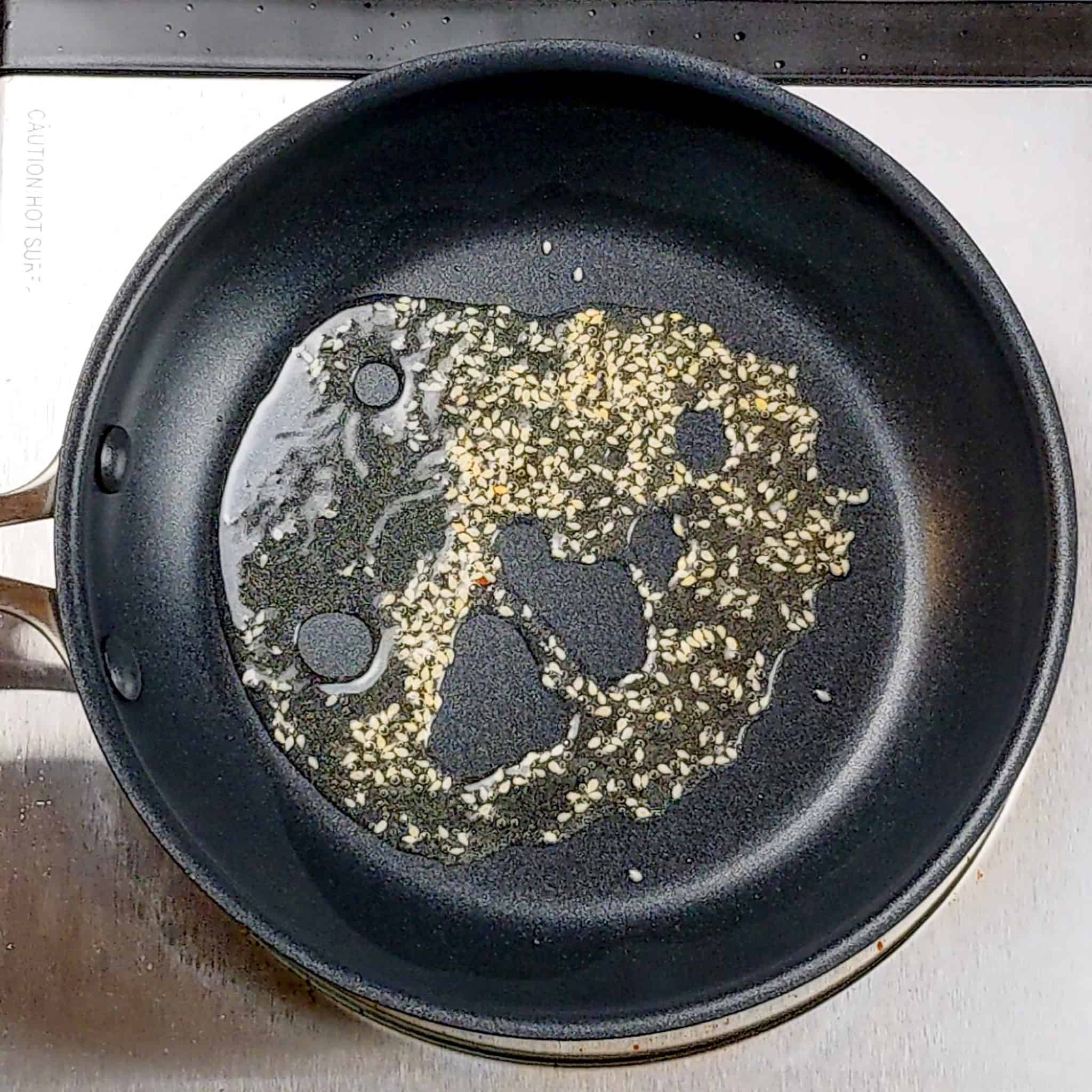
The sesame seeds will toast quickly.
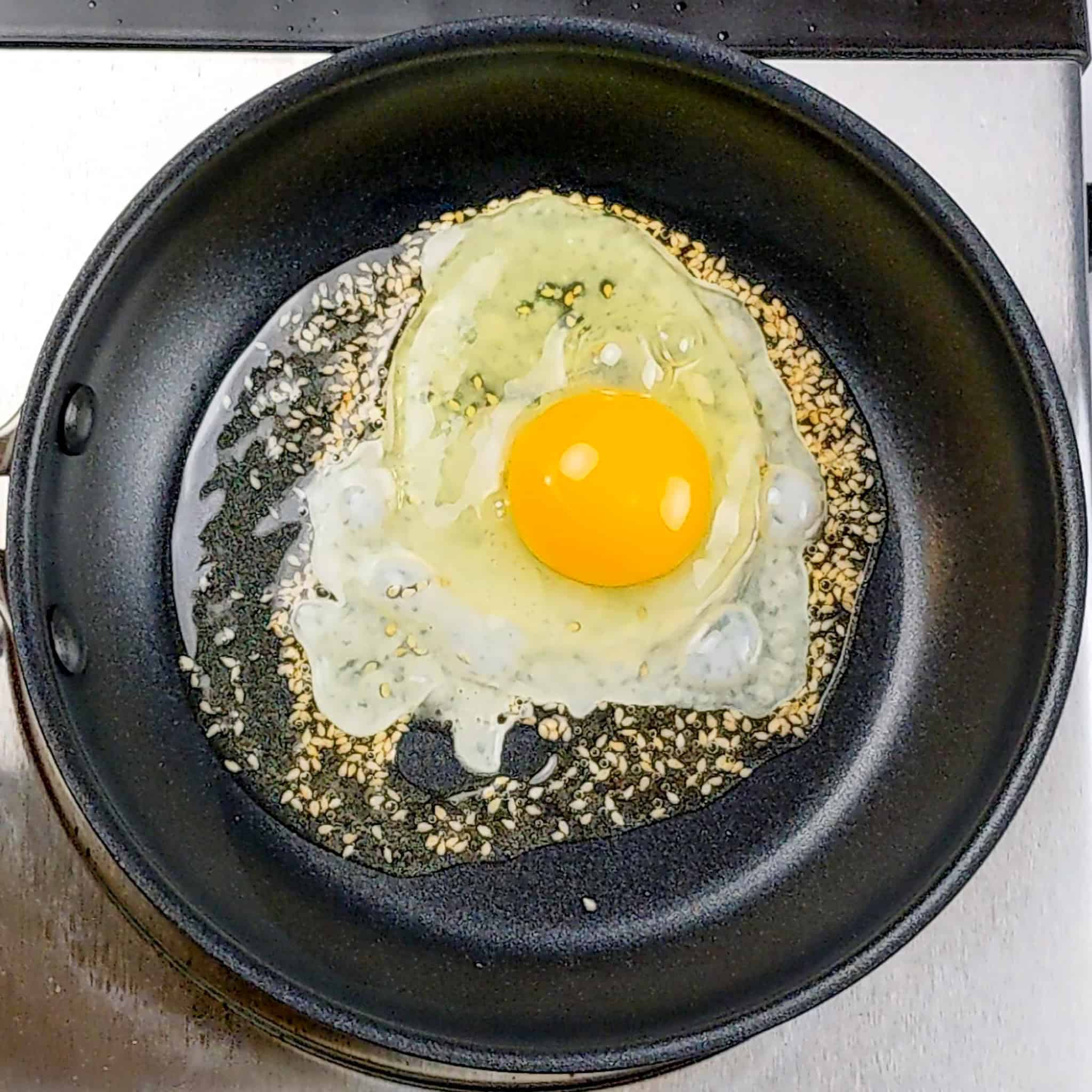
Ensure your eggs are ready to be cracked and fried.
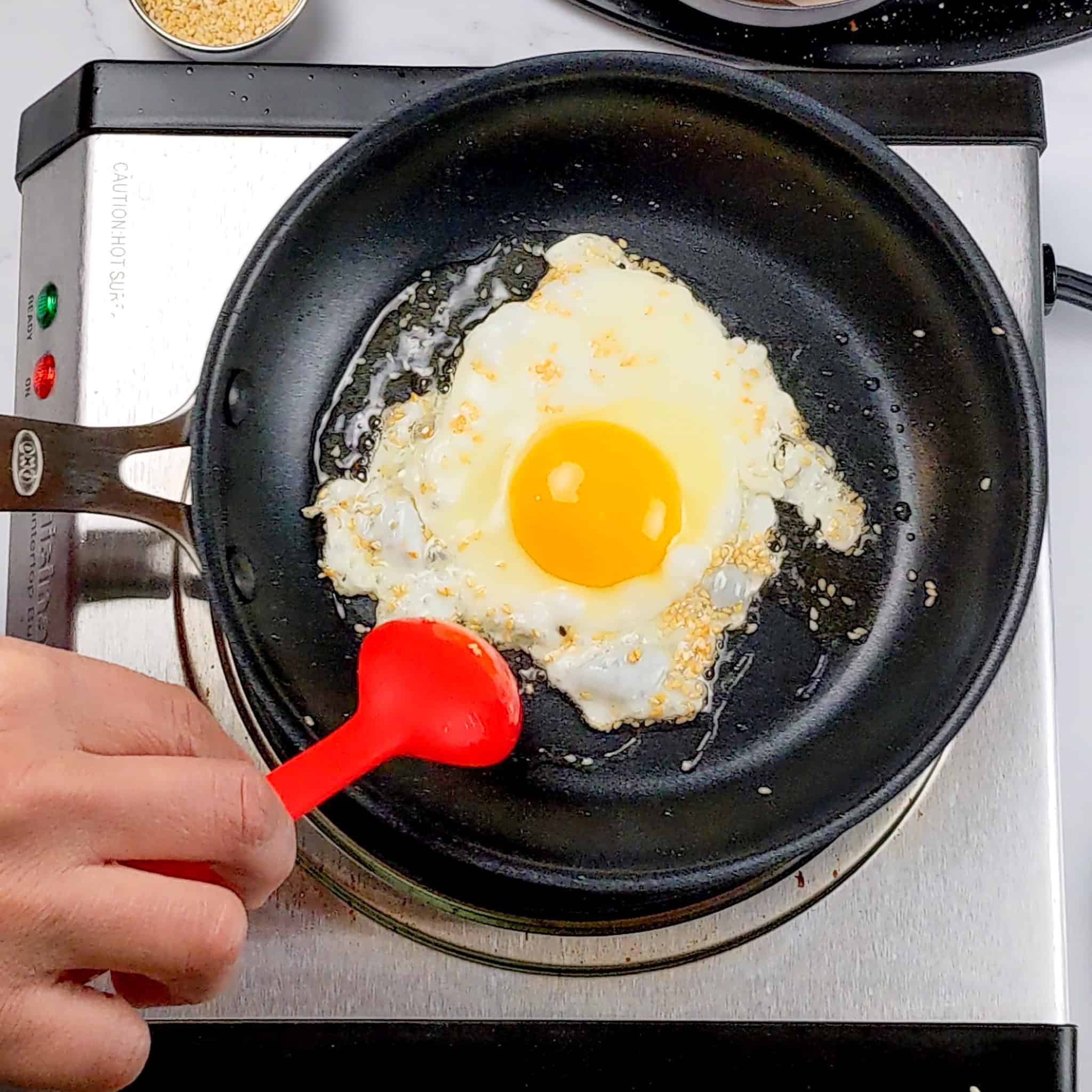
Use a silicone spoon in the non-stick frying pan to prevent scratching, and drizzle the hot sesame seed oil over the egg as it cooks.
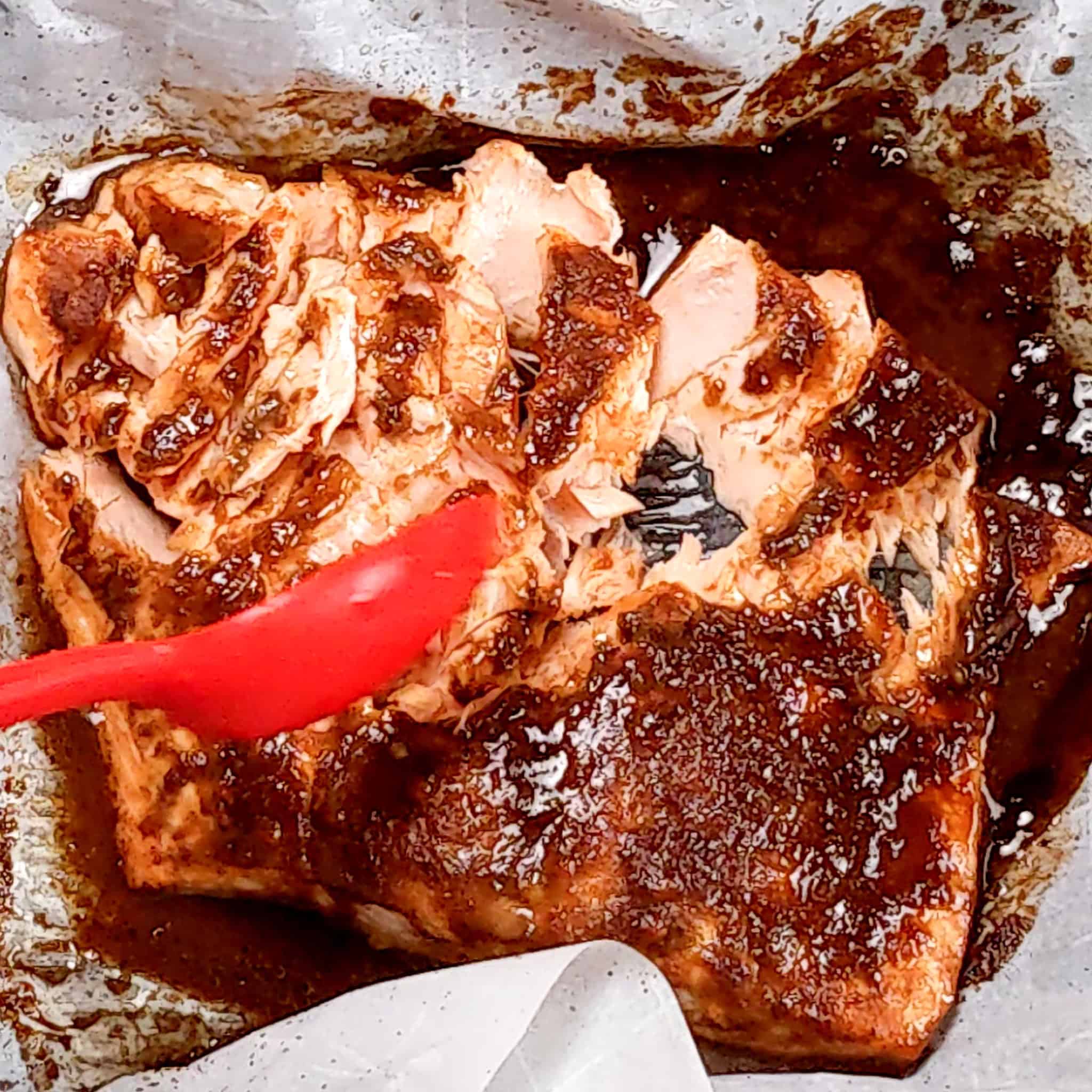
Use the same spoon to flake the cooked salmon and break it into large chunks.
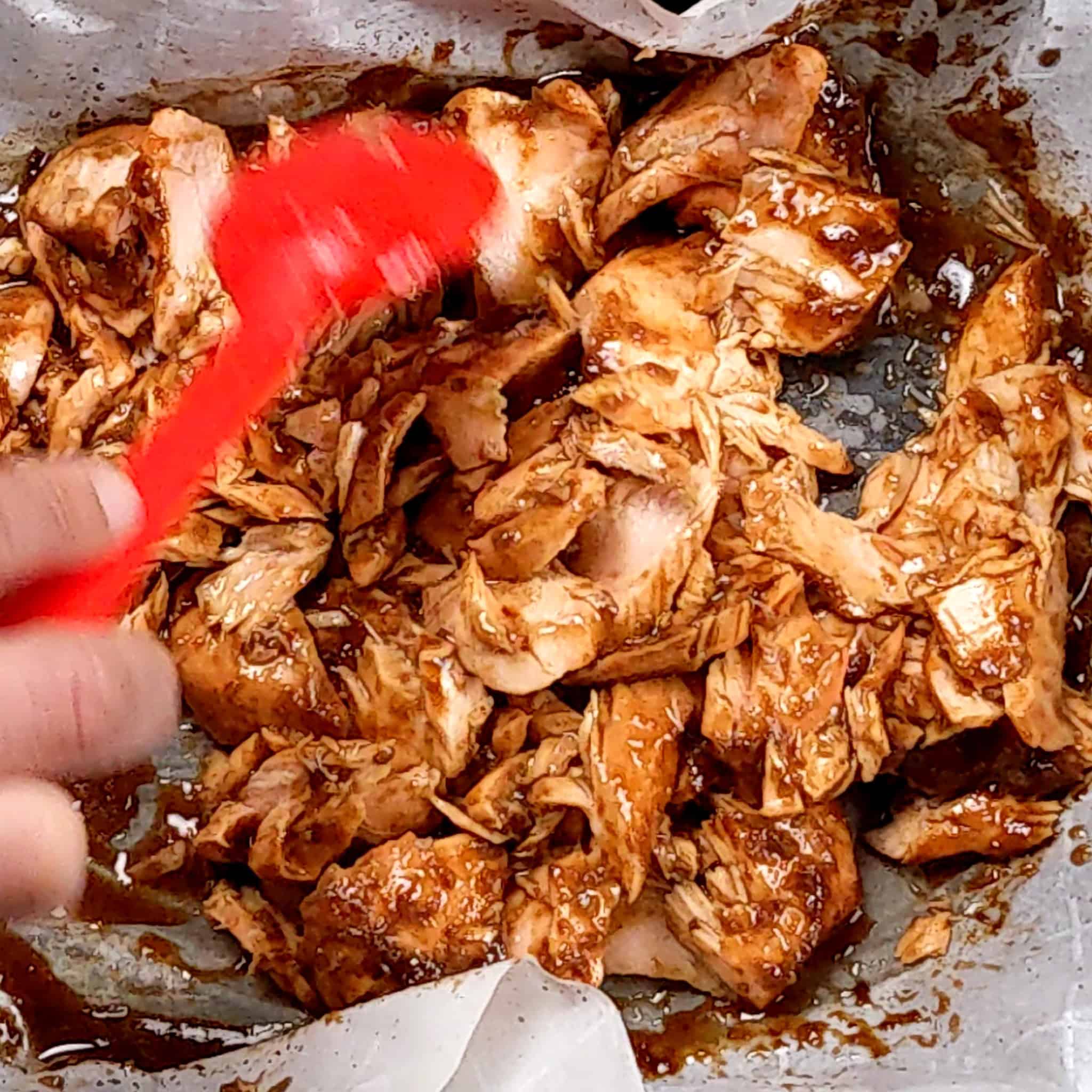
Using a spoon will help mix the sauce with the salmon chunks.
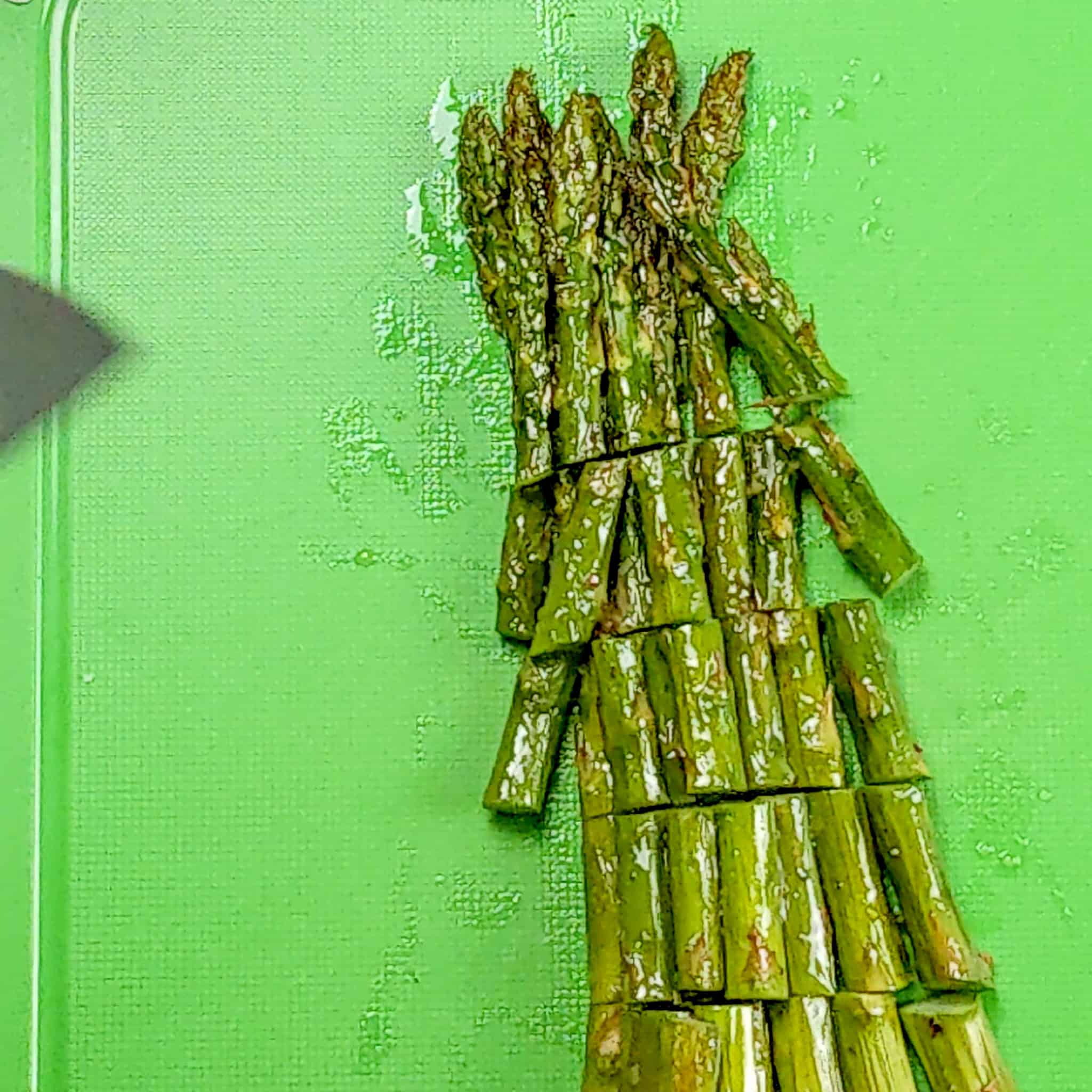
Cutting the asparagus into 1-inch pieces is a perfect way to eat it in a rice bowl, where all the ingredients will eventually be mixed together to enjoy.
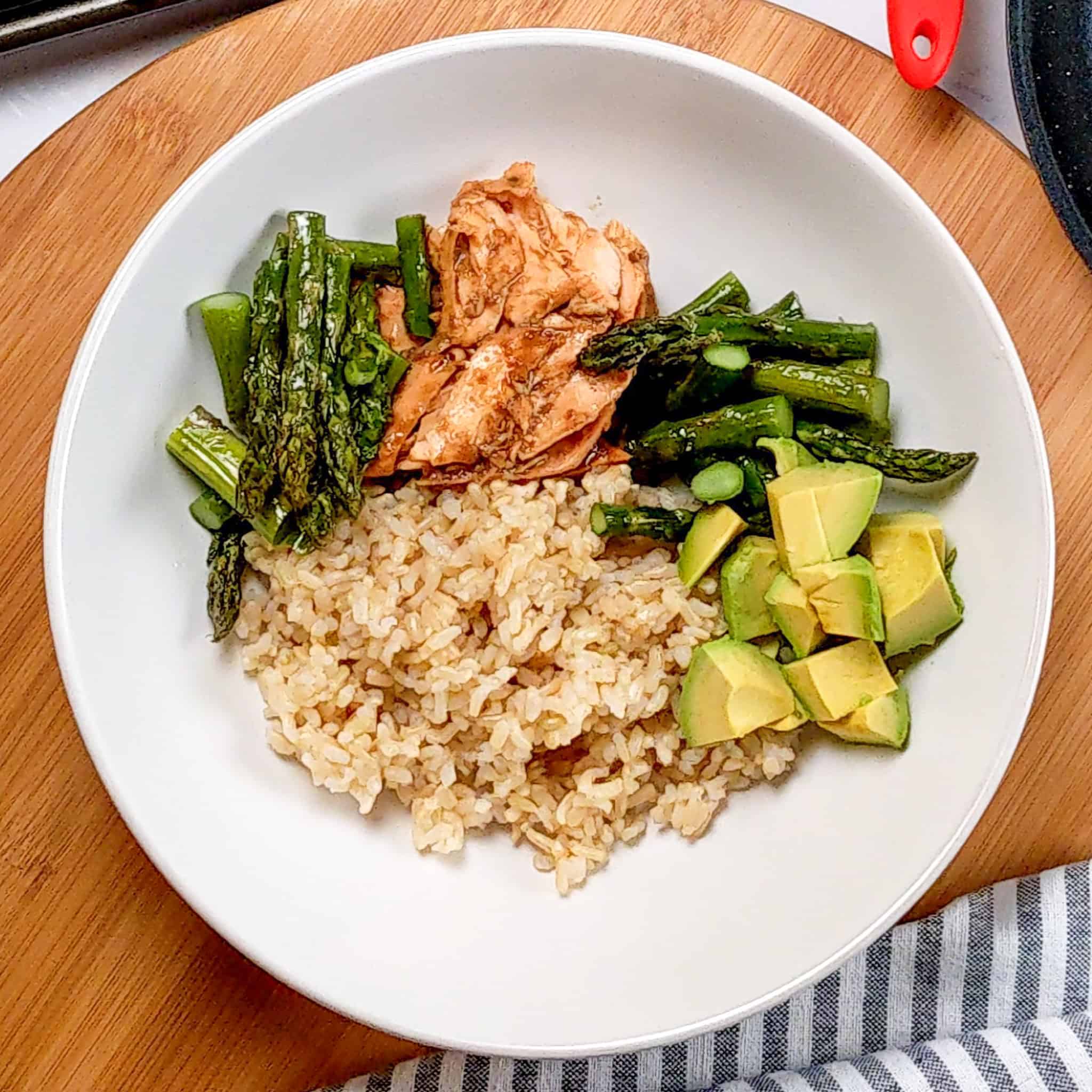
Portion the ingredients onto the plate, where the colors contrast to make them pop visually.
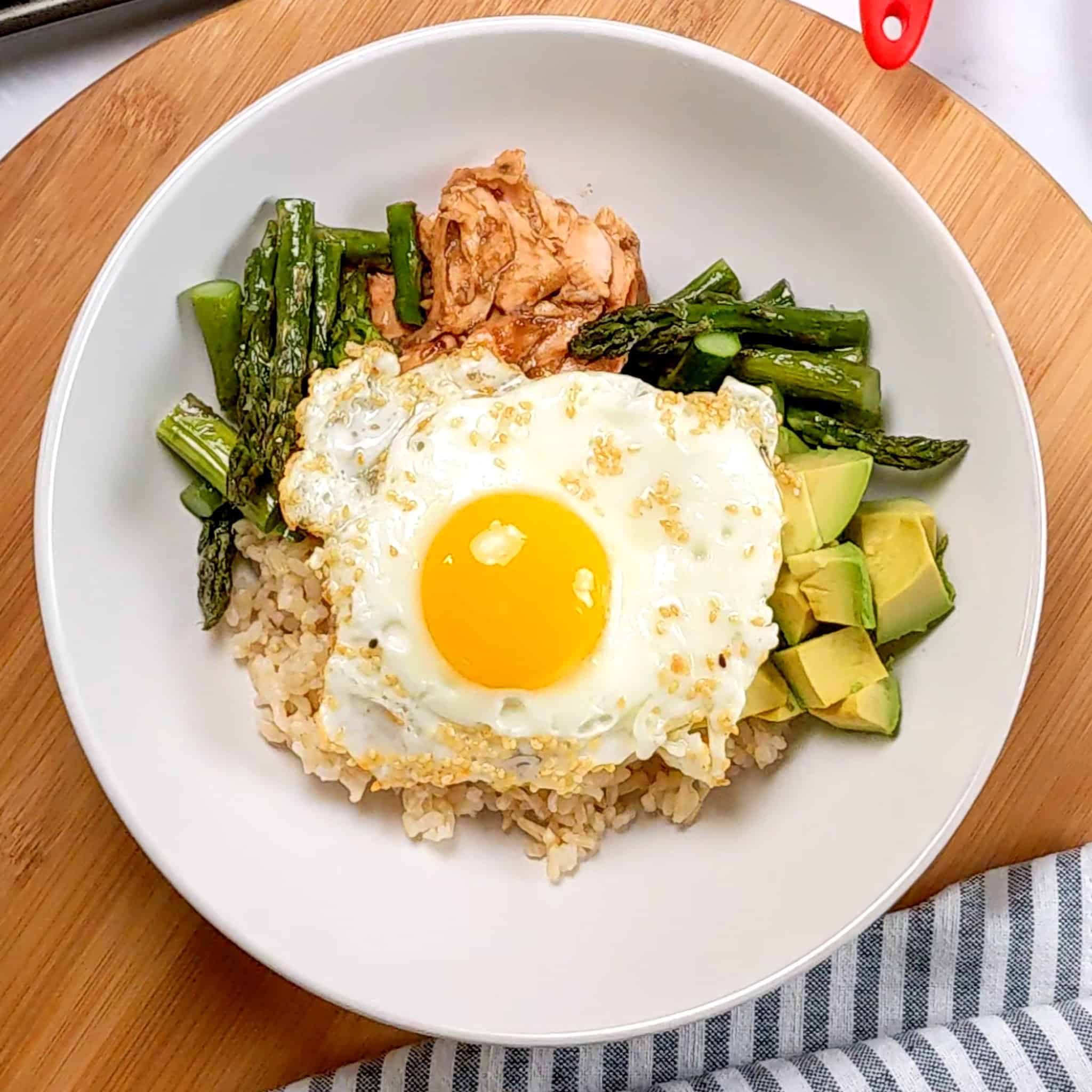
Then, add the egg on top and drizzle with sriracha, sesame oil, and Furikake seasoning for extra flavor.
Equipment
- Non-Stick Frying Pan - Used for frying the eggs. I use the OXO Good Grips Pro 8" Frying Pan Skillet. Ask any professional cook; we guard these pans like our babies. You take good care of it, and it will take care of you. This specific pan is also American Test Kitchen approved. However, if you are cooking a large amount of eggs, use a large skillet.
- Rice Cooker - Using a rice cooker ensures perfectly cooked rice every time with minimal effort, freeing up time and allowing you to focus on other aspects of meal preparation.
- Oven - The oven is used to bake the salmon and asparagus.
- Half Sheet Pan - (18-by-13-inch) Sheet pans are great for various cooking reasons, and I suggest you have one in your inventory along with a silicone liner and sheet pan rack.
- Silicone Sheet Pan Liner - These are easy to clean and reusable, and they're better than throwing away all that parchment paper every time you want to bake something.
- 8x8 Baking Dish - This is where you will place the salmon and the sauce to bake, to prevent spillage over to the asparagus. You can also use a quarter sheet pan, which is half the size of a half sheet pan.
Kitchen Must-Haves Reviews
Find a collection of my reviews of kitchen equipment that I have purchased or recommend. Kitchen Must-Haves - Find other tools I use here.
My Review: I absolutely love my Zojirushi NS-LGC05XB Micom Rice Cooker & Warmer. It’s hands down one of my favorite kitchen appliances. What really sold me is how precise it is; every batch of rice or quinoa comes out perfectly fluffy and evenly cooked, no guesswork needed. I also appreciate the variety of settings it offers, whether I’m making brown rice, multigrain rice, white rice, sushi rice, or even quick-cooking something simple, it handles it effortlessly. And let’s not forget the charming little songs it plays when it starts and finishes such a fun, quirky touch that always makes me smile while cooking.
Substitutions
Dairy-Free
- This spicy miso salmon bowl recipe is already dairy-free.
Gluten-Free
- Low-Sodium Soy Sauce - Soy sauce is not gluten-free because it is traditionally made from fermented soybeans, wheat, salt, and water, with the wheat component containing gluten.
- Try tamari, a Japanese soy sauce also made from fermented soybeans.
- Another alternative would be to use coconut aminos made from the fermented sap of coconut palms or liquid aminos, which go a long way and are also made from soybeans; all these will help you achieve the umami flavor similar to soy sauce needed for this recipe.
Vegetarian
- Salmon Filets - Just like the salmon, use a variety of mushrooms. Marinating it for a long time is unnecessary; just combine the ingredients and bake. You can also substitute this with tofu.
- I suggest using extra-firm tofu; you might have to use a tofu press. Learn more about prepping tofu here.
- Then dice into large cubes and air fry or roast without the asparagus.
- Then, toss it in the marinade and cook with the asparagus.
Convenience
- Ginger Paste - Use a 1-inch piece of fresh ginger for every tablespoon of ginger paste.
- Yuzu Hot Pepper Sauce - Yuzu is a Japanese citrus fruit. If you are not able to find it alone or as a hot pepper sauce, try to mimic the flavor by using one part lime juice to one part lemon juice with lime and lemon zest. For the hot pepper part, use jalapenos. Remove the seeds of the jalapeno and blend them with the citrus fruit.
- Mirin - This Japanese rice wine has a syrupy consistency that is on the sweet side; you can substitute it with brown sugar or corn syrup.
- Salmon Filet - If your salmon still has the skin on, this is okay. Just follow the instructions in the recipe by baking it skin side down. After it's done baking, gently flip the salmon over to peel off the skin. Then, you can flake the salmon.
Change Heat Level - Modify the Miso Salmon Rice Bowl recipe's heat level to your liking and learn more about the Scoville Scale and Chili Pairings.
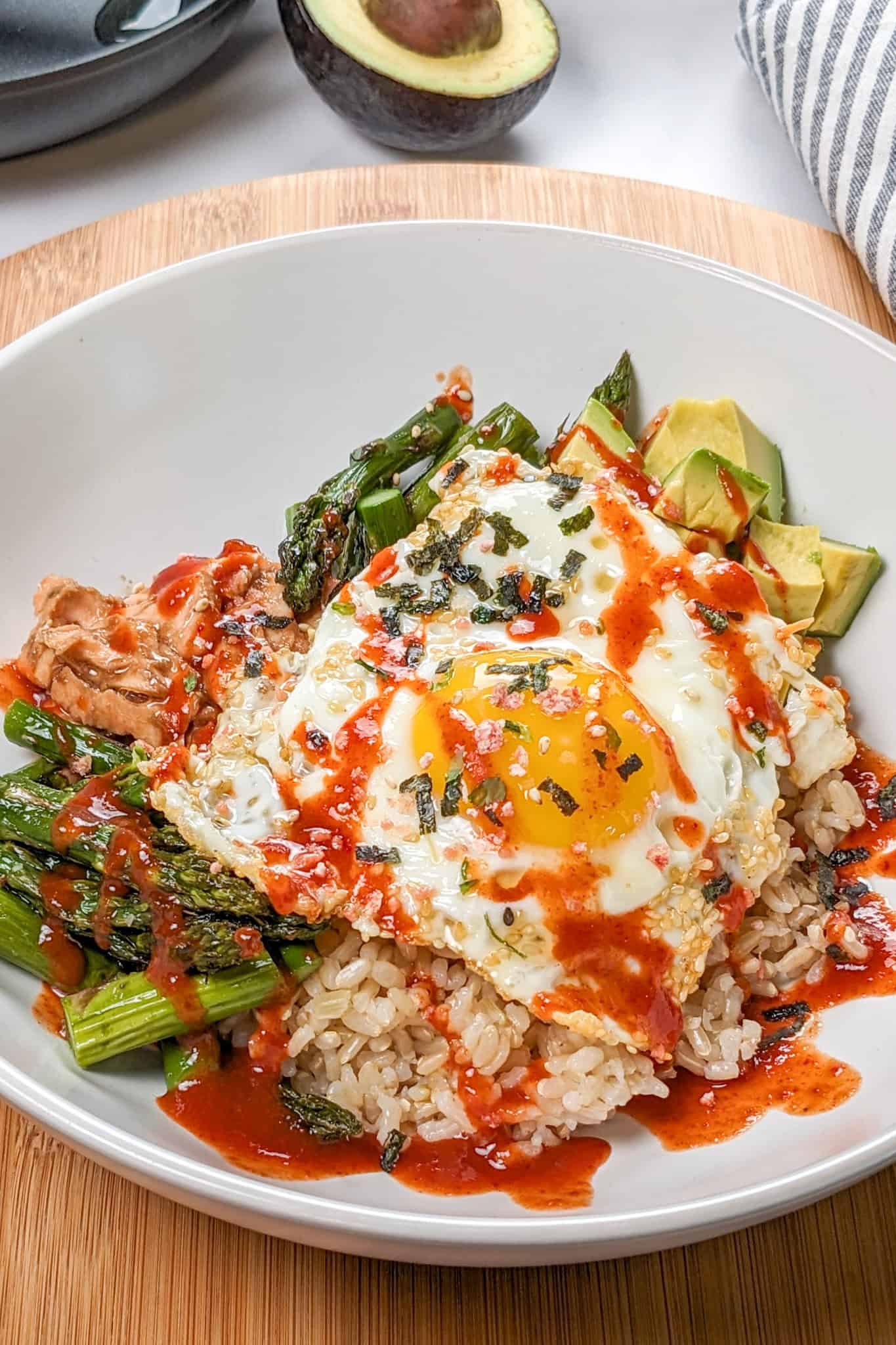
Variations
- Cubed Salmon - If you prefer not to remove the skin from the salmon:
- Cut it into large chunks to make salmon bites, pour the marinade over the chunks in the baking dish, and follow the rest of the recipe.
- Remember that this will alter the cooking time, and the salmon will be done before the asparagus unless you swap the jumbo asparagus for thinner pencil asparagus.
- Plus, you can use your air fryer to cook these at 400 degrees Fahrenheit for 8 minutes.
- Sriracha Mayo - For a creamier meal, mix the sriracha with one part Kewpie mayo, a Japanese mayonnaise that uses more egg yolks than American.
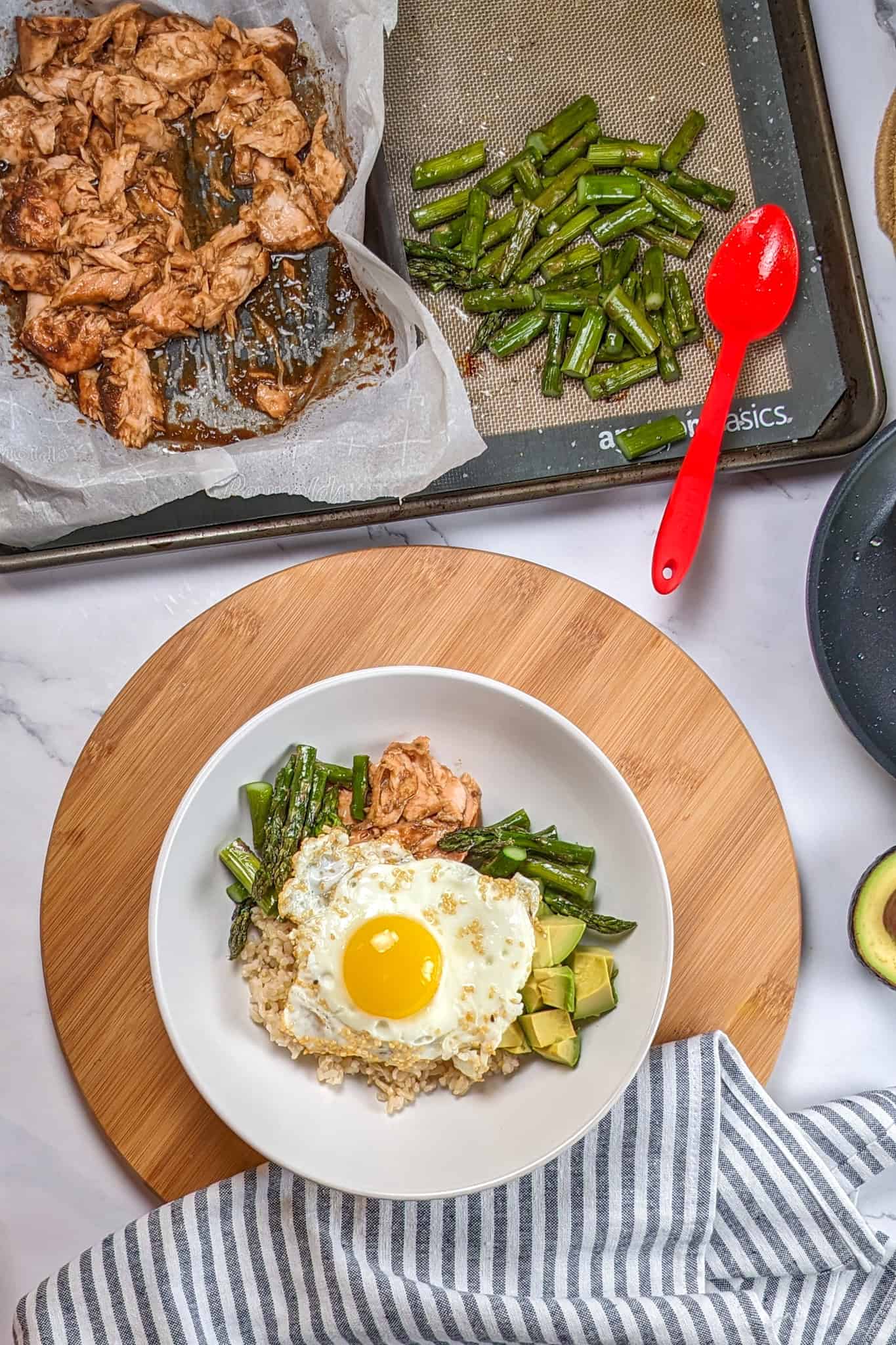
Storage
- Refrigerator - To store in the fridge, place asparagus and salmon in a shallow 2-inch container to cool down quickly. Then, store it in an airtight container. The meal will last up to two days.
- Freezer - Follow the refrigeration process mentioned above. Then, place it in the freezer in a labeled, airtight container. However, I do not suggest freezing the asparagus; when frozen, the amount of water will drastically change the vegetable's texture to a soggy mess.
Cooking Tip
- Various Ways to Cook the Asparagus - The previous tips are generally for medium-thickness asparagus. For jumbo asparagus, increase the time to 15-18 minutes in the oven and 10-12 minutes in the air fryer, while for pencil-thin asparagus, reduce the time to 8-10 minutes in the oven and 5-7 minutes in the air fryer.
Frequently Asked Questions
Japanese miso paste is typically made with soybeans and rice or barley, resulting in a smoother texture and a flavor profile that can range from sweet and mild (white miso) to robust and salty (red miso).
On the other hand, Korean soybean paste, or doenjang, is made only from soybeans and salt, resulting in a chunkier texture and a more intense, earthy, and pungent flavor. Despite these differences, both pastes add deep umami notes to dishes and can be used interchangeably in some recipes to provide a rich, savory complexity.
Miso paste, a traditional Japanese seasoning, comes in various types distinguished by their ingredients, fermentation time, and flavor profiles. The most common types are white miso (shiro miso), red miso (aka miso), and mixed miso (awase miso).
White miso is made from soybeans and rice, fermented for a shorter period, resulting in a mild, slightly sweet flavor. On the other hand, red miso is fermented longer, often with a higher proportion of soybeans, giving it a stronger, saltier taste and darker color.
Mixed miso combines white and red miso, offering a balanced flavor profile. White miso is often recommended for its versatility in various dishes such as soups, dressings, and marinades. Its milder taste makes it suitable for a wide range of recipes. Therefore, I recommend finding and using white miso paste.
Miso paste should be stored in an airtight container in the refrigerator to maintain its freshness and prevent contamination. Keeping it refrigerated slows the fermentation process, preserving its flavor and quality.
Miso can last several months to over a year, depending on its type and storage conditions. With its shorter fermentation time, white miso may have a slightly shorter shelf life than red miso, which continues to develop its robust flavors over time.
Always check for any changes in color, texture, or smell as spoilage indicators. Properly stored miso remains a reliable and flavorful ingredient for many delicious meals in your kitchen.
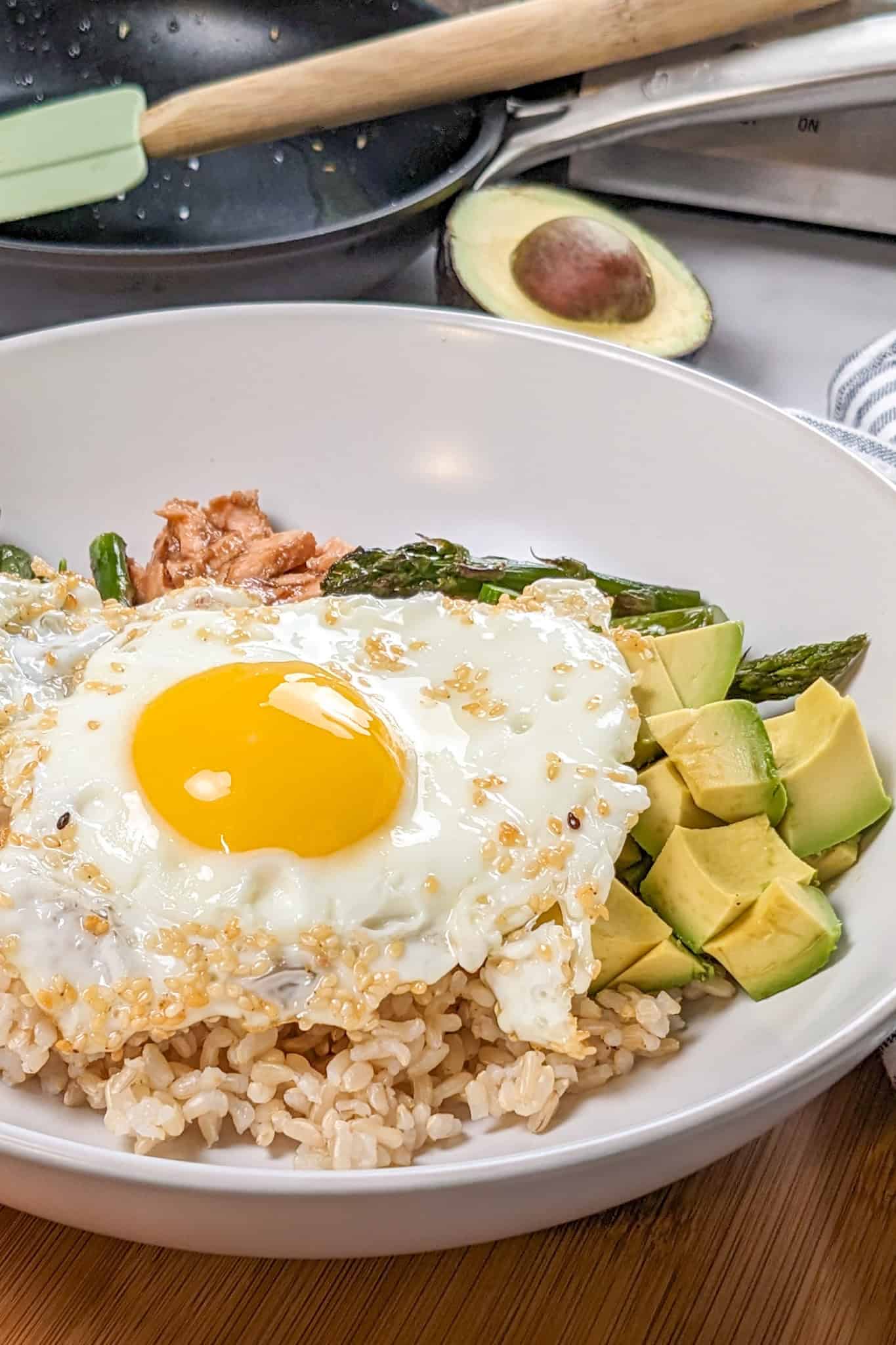
Rice Bowl Recipes
Looking for other rice bowl recipes like this? Try these:
- Spicy Cajun Shrimp Rice Bowl with Lemon Remoulade
- Spicy Greek Chicken Meatball Rice Bowl
- Calabrian Chili Salmon and Vegetables Bowl
- Air Fryer Spicy Cilantro Lime Salmon Salad Rice Bowl
Seafood Recipes
Looking for other seafood recipes like this? Try these:
- Creamy Haitian-Style Shrimp Mac and Cheese with Gouda Cheese
- Air Fryer Jerk Shrimp Fajitas | Easy Caribbean in 20 Minutes
- 20 Irresistible Fish Recipes
- Healthy Haitian-Style Creole Spicy Shrimp Pasta
Subscribe to My YouTube Channel
📖 Recipe
Easy Sheet Pan Spicy Miso Salmon Rice Bowl
Ingredients
Rice
- 1 cup brown sushi rice or regular sushi rice
Spicy Miso Ginger Salmon
- 1 tablespoon miso paste
- 1 tablespoon mirin
- 1 tablespoon rice vinegar
- 2 tablespoons low-sodium soy sauce
- 1 tablespoon ginger paste
- 1 teaspoon toasted/ roasted sesame oil
- 1 tablespoon yuzu hot pepper sauce
- 1 pound salmon filet skinless
Rest of the Bowl
- 1 bunch asparagus
- 1 tablespoon avocado oil
- ¼ teaspoon kosher salt
- ¼ teaspoon ground black pepper
- 1 tablespoon sesame seeds white, black or both
- 4 large eggs
- 1 avocado
- ¼ cup sriracha sauce
- 4 tablespoons toasted sesame oil
- Optional: Salmon Furikake Seasoning
Equipment
Instructions
- Save time in the kitchen: Read the instructions thoroughly, then gather and prep all your ingredients before cooking! Learn Prepping Tips.
- Cook the Rice: To cook brown sushi rice in a rice cooker, rinse the rice thoroughly, add the appropriate amount of water (typically 2 cups of water for every cup of rice), and set the cooker to the brown rice setting.
- To cook brown sushi rice on the stovetop, rinse the rice thoroughly, combine 1 cup of rice with 2 ½ cups of water in a pot, bring to a boil, then reduce the heat, cover, and simmer for about 45 minutes or until the water is absorbed and the rice is tender.
- Note: Depending on the type of rice used, the rice takes about 35 to 50 minutes to cook. Brown sushi rice typically takes about 45-50 minutes to cook in a rice cooker or on the stovetop.
- Set the Oven: Preheat the oven to 400 degrees Fahrenheit.
- Make the Salmon Marinade: Combine miso paste, mirin, rice vinegar, soy sauce, ginger paste, sesame oil, and yuzu pepper sauce in a small mixing bowl.
- Prepare the Sheet Pan: Line the sheet pan with parchment paper or a silicone liner to make cleaning up easier and prevent sticking. Next, line an 8x8 baking dish or a baking tray half the size of the sheet pan with parchment paper.
- Prepare the Salmon: Place the salmon filet onto the baking dish and cover it with the miso marinade.
- Prepare the Asparagus: Cut off the woody bottom part of the asparagus by either snapping it off or using a sharp knife to remove at least two inches from the bottom. Then, arrange the asparagus evenly on the empty side of the sheet pan. Drizzle with avocado oil, and sprinkle with salt and pepper.
- Cook the Salmon and Asparagus: Place the sheet pan in the oven and bake for 15 to 20 minutes or until the salmon's internal temperature is 145 degrees Fahrenheit. The asparagus should be bright green and tender with a firm bite.
- Fry the Eggs: After the salmon, asparagus, and rice sheet pan are done, heat a non-stick frying pan over medium heat with oil. Sprinkle in a pinch of sesame seeds; they will toast quickly in less than 15 seconds; no need to wait for them to turn golden brown.
- Crack and add an egg to the seeds, sprinkle some more seeds on top, and cook until the white part of the egg has set. Remove the pan from the heat and set it aside. You can spoon the remaining seeds in the oil over the white part of the egg while it cooks.
- Note: You can use a large pan to fry four eggs or a small one to toast one. The eggs can sit in the pan off the heat to assemble the rest of the bowl.
- Finish the Bowl: Flake the fish in the baking dish with spoons and combine it with the sauce. Then, cut the asparagus into one-inch pieces and add them back to the sheet pan.
- Assemble the Bowl: Evenly distribute the rice, asparagus, and salmon onto each plate. Dice and add avocado chunks. Place the fried egg on top and drizzle the sriracha sauce and a generous amount of sesame oil.
- Optional: Sprinkle on more sesame seeds or use Salmon Furikake seasoning for extra flavor and texture.
Video
Nutrition
SUBSCRIBE: 👈To my YouTube Channel to Get Notifications of New Videos.
Have a Comment or Question?
If you have a question or comment about this Miso Salmon Rice Bowl recipe, please post it below. You will definitely get a quick response. It also helps our other readers to stay informed. Thanks!


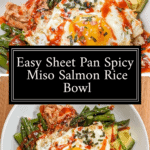
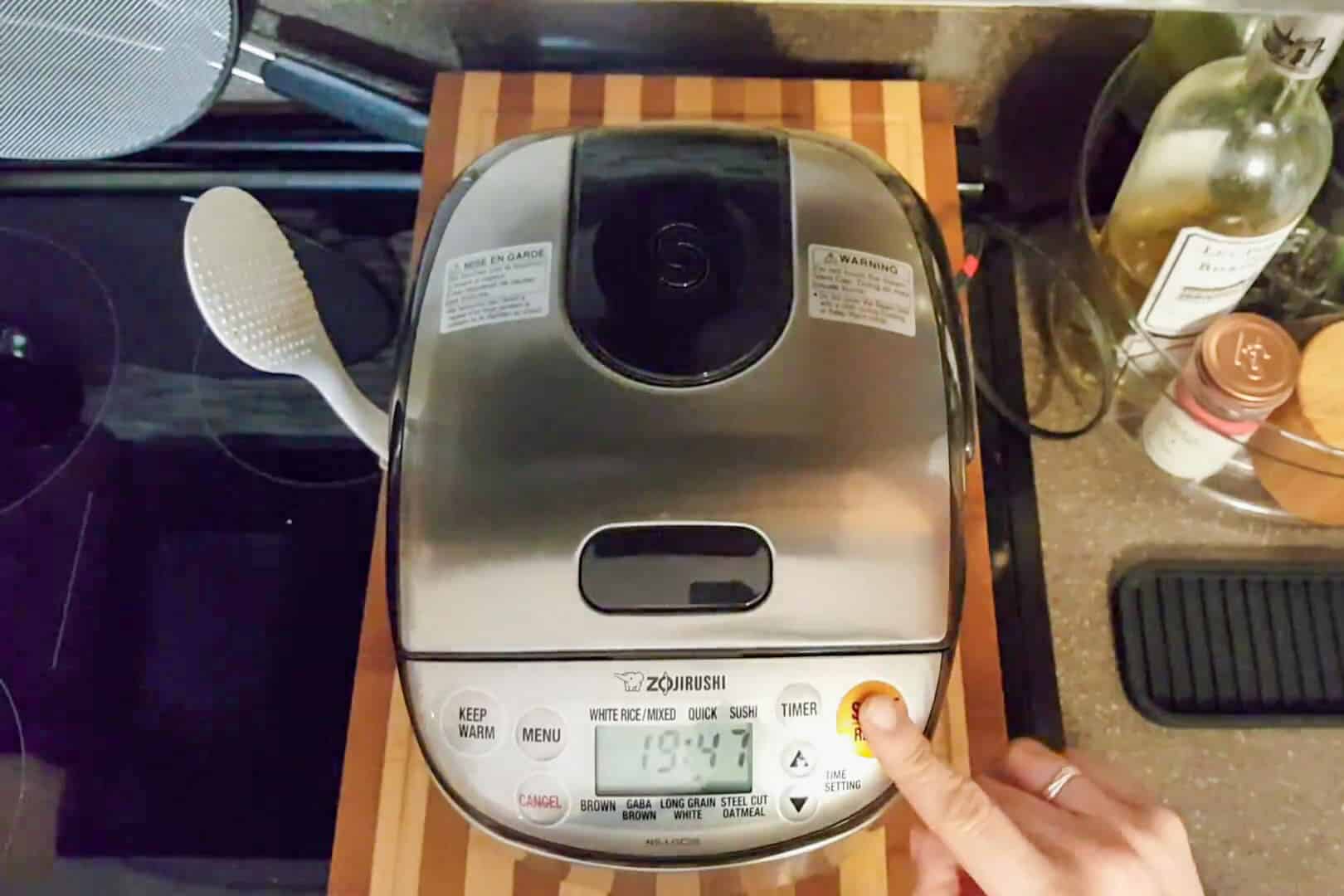

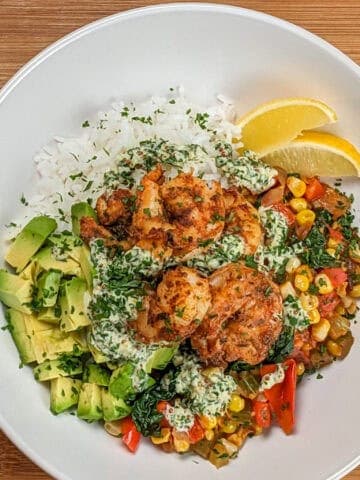


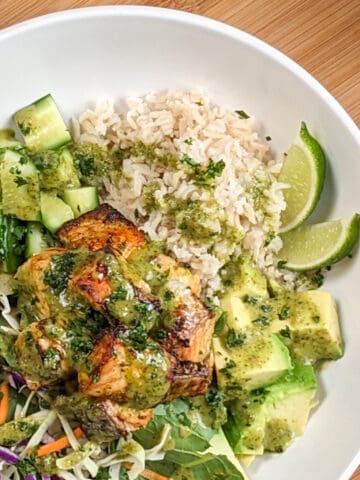
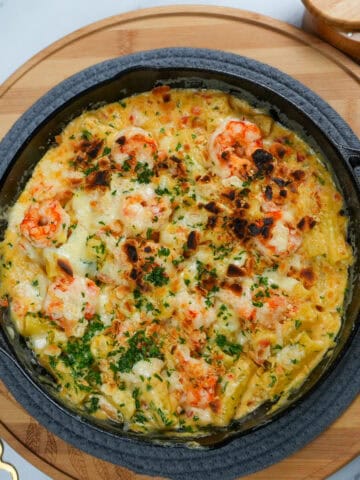
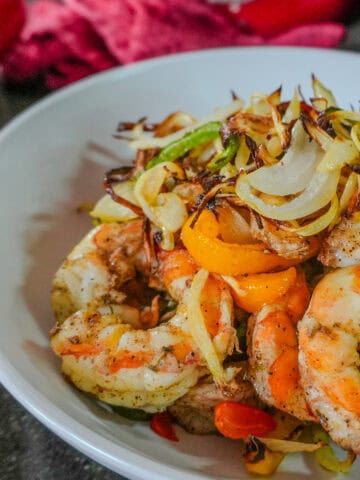
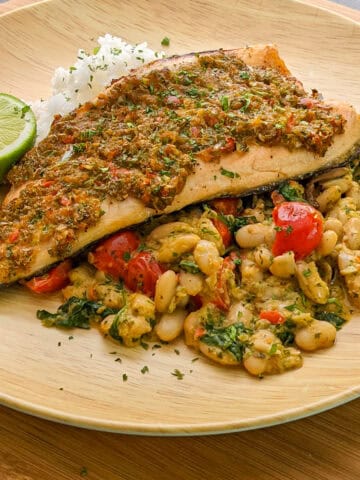
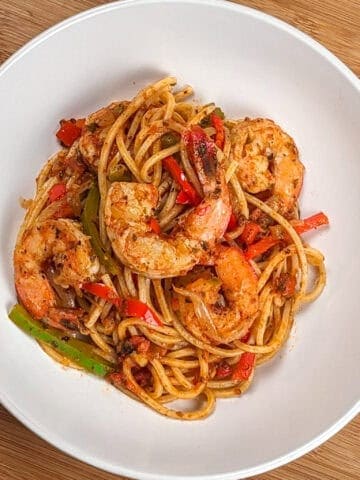

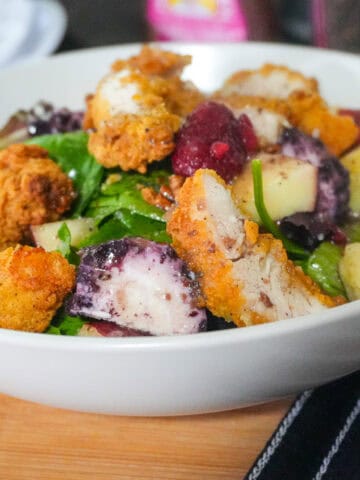
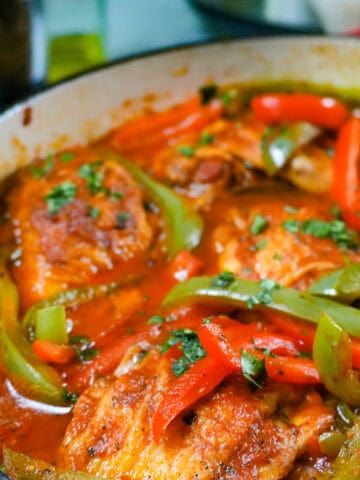


Leave a Reply